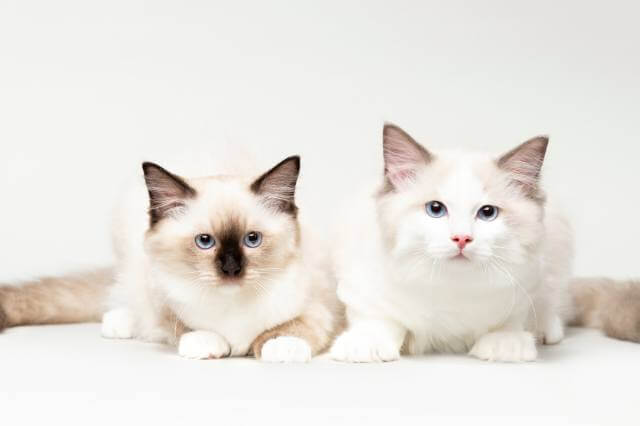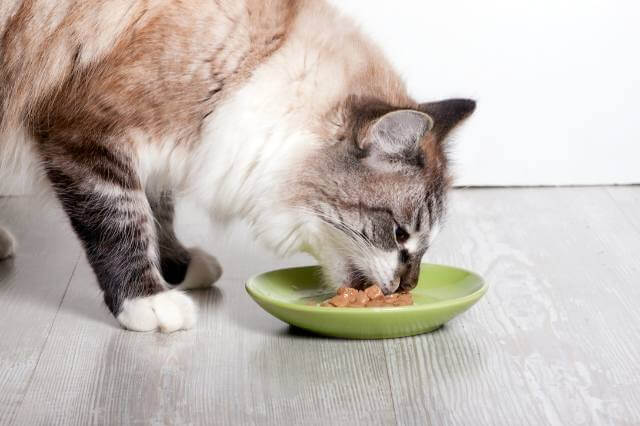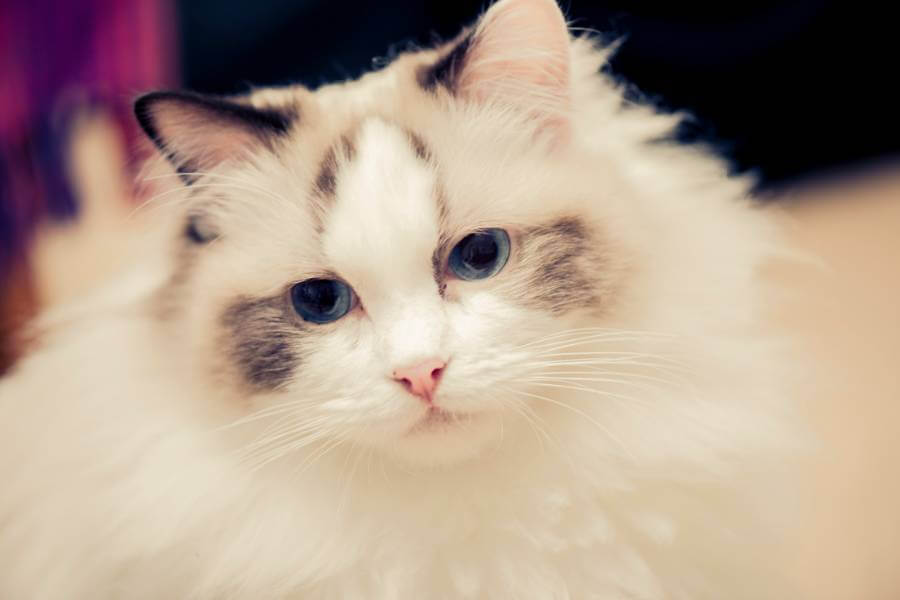A ragdoll cat breed has bright blue eyes and tends to be more affectionate and needy.
Owners of ragdolls are frequently concerned about their pets’ feeding habits, food intake, and other factors.
How often to feed ragdoll cats? If you’re looking for the same answer, you’ve come to the correct spot.
Table of Contents
How Often to Feed Ragdoll Cats?
The diet of a Ragdoll cat is the same as that of any other cat breed, however, Ragdolls consume food 5 to 8 times daily more often.
When these cats are starving and in need of food, they will meow.
They frequently have a passion for food, which is seen in their upbeat conduct when food is presented.
Knowing that there are several kinds of cats and that there are some fundamental distinctions between the two can help you decide which one you want to acquire.
The majority of domestic cats have soft palates and tongues adapted for eating little foods like grains and fruits.
These cats also tend to eat less since a large portion of their meals consists of meat.

What Calories Should I Feed My Ragdoll Cat?
People frequently disagree on how many calories their ragdoll kittens and adult cats should consume.
Well, the answer you’re all seeking is right here.
The national research council recommends starting with 200 kcal and gradually increasing it to 250–280 kcal per day for your cats.
However, if your ragdoll breed has reached adulthood and weighs up to 15 pounds, it may need at least 360 kcal each day.
A feeding chart for Ragdoll cats is shown below, organized by weight:
| Weight | Daily Calories |
| 2 – 3 lbs | 160 – 230 kcal/day |
| 4 – 5 lbs | 270 – 330 kcal/day |
| 6 – 7 lbs | 370 – 420 kcal/day |
| 8 – 9 lbs | 450 – 500 kcal/day |
| 10 lbs+ | 550 kcal/day |
How Much Should I Feed My Ragdoll Cat?
Up to the age of six months, a kitten should be fed three to four times a day with moistened canned cat food.
As the kitten grows and matures, its food consumption will fluctuate.
They should be fed moistened canned cat food twice a day from the age of six months to one year.
Once they are a year old or older, they can be fed canned food once a day and dry kibble once a day.
Despite the fact that a kitten’s hunger might vary, it’s generally recommended to give them as much food as they desire in the first few weeks.
As they become older and get closer to maturity, they should start eating a bit less.
Until they are mature enough to consume an adult diet, kittens should be fed high-quality kitten food.
Veterinarians may advise specialized diets for particular health issues.
Please consult your veterinarian to learn more about potential reasons and treatments if your ragdoll cat appears to be eating more than normal or has lost weight.

What Should I Feed a Kitten Ragdoll?
To maintain their enormous frames, ragdoll cats need a diet high in protein, and the greatest protein source for this species is beef.
Regular use of wet food based on whole meat makes these cats the healthiest.
Compared to processed protein replacements like meat, fish, plants, and dairy, whole meat has more nutrients and is more physiologically suitable.
Nutritionists advise feeding ragdolls food with over 50% animal protein, 20% fat, and no more than 3% carbohydrates to mirror the nutritional profile of the typical feline diet.
Ragdolls should obtain 90% of their daily caloric needs from proteins and lipids.
In ragdolls, carbohydrates should be avoided since they might increase weight and irritate the stomach.
How Much Food Should I Give Them as They Become Older?
Although a kitten’s appetite varies, throughout the first several weeks you should give them as much food as they desire.
They ought to start eating less as they get older and get closer to maturity.
Veterinarians may advise customized diets to address particular health conditions.
Consult your veterinarian to learn about potential reasons and treatments if your ragdoll kitten is eating more than normal or is losing weight.
Watch out for cat food items that pack in too many extra calories by using excess carbs.
Kittens need a diet high in calories, but the calories must come from protein rather than from carbs.
Lean protein sources like chicken and fish should be fed to your kitten as well.
High-fat protein sources like eggs, pork, cattle, and lamb should be avoided.
Until they are old enough to eat adult food, kittens should be fed high-quality kitten food.
You should always keep high-quality dry kitten food on hand and provide two to three canned meals per day, depending on your cat’s caloric requirements, if you wish to feed your kitten both wet and dry food.

Meals for Cats Without Grains
To begin with, you must buy grains that are grain free if you want your cat to consume more grains.
The good news is that grains, even those made without grains, still contain a lot of protein.
The bad news is that you must purchase grains at a reasonable price in order to prevent the grain from just passing through your cat’s digestive tract and never reaching its heart.
Cooking the grains could help you get rid of them, which is OK because your cat might still benefit from them.
Buying animal products like beef, chicken, and turkey provides an additional choice.
These include meat and can provide your cat with a sufficient quantity of protein, but they are not a suitable option for your cat because they are high in fat and cholesterol.
As a result, your cat is more prone to put on weight.
If you decide to use animal products, be sure to research their ingredients and processing methods so you can pick the ones that will provide your cat with the optimum nutrition.
You may choose between canned or dry kibble if you want to provide your cat with the right quantity of vitamins and minerals.
These offer several advantages for your cat and are simply loved by certain cats.
All the nutrients your cat needs to keep healthy may be found in these meals, including vitamin A, which is good for their skin and bones.
As you can see, there are several solutions available to assist in ensuring that your cat receives the appropriate quantity of minerals and vitamins.
Your cat will eventually be happy and healthy with a diet that offers a mix of proteins, carbs, and fats for a long, happy life; it just takes some study and persistence.

FAQs
Do Ragdolls Have Sensitive Stomachs?
Cats frequently experience stomach problems that resolve in a few days. The ragdoll breed is particularly prone to stomach issues.
Ragdolls are prone to a number of persistent stomach problems. This makes them prone to diarrhea.
If you’re wondering whether or not ragdolls have sensitive stomachs, the answer is yes, and they should be maintained under close care.
In order to prevent such digestive issues, their daily food should be closely watched. Diets for ragdolls should be monitored daily.
Is a Special Diet Required for Ragdolls?
Given that ragdoll owners may be aware that this breed is a carnivore, it is strongly advised to provide them with enough meat and proteins designed specifically for animals.
They need to eat like this in order to develop into huge, healthy cats.
They can consume a vegetarian diet, however, it is advised to include meat and proteins for their rapid growth.
Cats are unable to produce vital amino acids, such as taurine, thus they must eat them.
Animal protein is crucial in this situation since it provides cats with taurine.
You should exercise caution when selecting a protein since there are two varieties available on the market: plant and animal.
For ragdolls, only animal protein is suggested.
Could Ragdolls Consume Raw Meat?
You can certainly give raw meat to your ragdoll. It’s one of their favorite diets, and the wet raw meat keeps them hydrated.
Since meat contains a significant amount of proteins, raw meat also satisfies their need for protein.
Conclusion
Finding out how much food your new ragdoll kitten needs might be difficult when you first bring them home.
Measuring and scheduling your kitten’s meals is the first step in ensuring that it grows up strong and healthy.
Make sure your pet gets the right nourishment and the appropriate amount of activity if you want to ensure a long and healthy life for them.
Generally speaking, it is better to stay away from dry meals and kibble and choose a diet that is strong in protein, fiber, and low in fat.
This article should have provided you with answers to your questions about how often to feed ragdoll cats.
Related:

